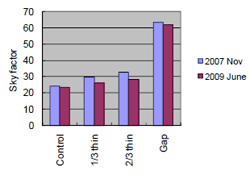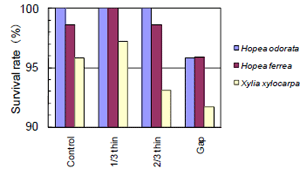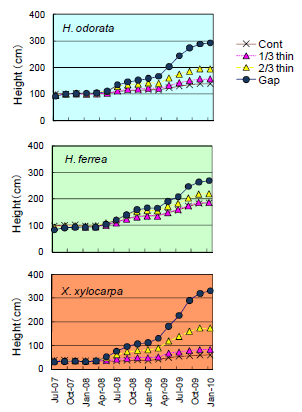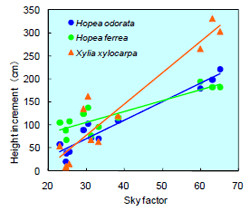Group selection thinning is effective for the conversion of fast-growing tree plantations into indigenous tree forest
Description
There had been attempts to restore degraded lands into forests using local tree species around the world. However, the planting of local tree species in an open site often ended in failure in tropical areas due to the strong sunlight and high temperature. We have improved the silvicultural system in which local tree species can be introduced after establishing a fast-growing tree plantation under a tropical monsoon climate in northeast Thailand. We evaluated what thinning pattern is best suitable for the survival rate and growth of local tree species that are planted beneath a fast-growing tree plantation.
Free selection thinning (1/3 and 2/3 at basal area base) and group selection thinning (50m x 60m in size) were applied to 23 year-old A. mangium plantation. Seedlings of three local tree species (Hopea odorata, H. ferrea and Xylia xylocarpa var. kerrii) were planted at each experimental site with a spacing of 2 m x 3 m. The survival rate and growth of the seedlings were surveyed every two months. Relative light intensity was highest in the group selection thinning plot (gap plot) followed by the 2/3 free selection thinning plot, 1/3 free selection thinning plot and control plot (no thinning). The light condition tended to return to the initial level in the free thinning plots as canopy was recovered, while it kept to a high level in the gap plot (Fig. 1). The seedlings showed high survival rate (>90%) across all species and treatment (Fig. 2). It seems that the fast-growing trees mitigate strong sunlight for the seedlings, because the survival rate of the seedlings was generally low (60-80%) in the open site. The seedlings showed seasonal growth pattern in which their growth was inhibited during the dry season (from Dec. to next Feb.) and improved during the rainy season (Fig. 3). Height growth was promoted in all species as the light condition improved: exhibiting best growth in the group selection thinning plot and worst in the control plot (Fig. 4). H. ferrea achieved better growth with increased height even in dark conditions, suggesting that this species is considerably shade-tolerant. In contrast, X. xylocarpa var. kerrii was considered to be light-demanding. These growth performances seem to be associated with the regeneration patterns in their natural habitats.
These findings suggest that group selection thinning is the most suitable technique in terms of providing the ideal light conditions (60-65% of open site) for the local tree seedlings. Young plantations would not be suitable for this method because their canopies will recover quickly, shading the local tree seedlings. In order to avoid competition with the weeds and lianas in such a bright condition, weed cutting must be carried out at least three times a year.
Figure, table
-
Fig. 1.
Light conditions in each experimental plot. “Sky factor” indicates relative light intensity against the completely open site ranging from 0 to 100. -
Fig. 2.
Survival rates of local tree seedlings at 30 months after planting in each plot. -
Fig. 3.
Height growth profiles of the local tree seedlings. -
Fig. 4.
Relationship between light conditions and height increments of the seedlings.
- Affiliation
-
Japan International Research Center for Agricultural Sciences Forestry Division
- Classification
-
Administration B
- Term of research
-
FY2006~2010
- Responsible researcher
-
SAKAI Atsushi ( Forestry Division )
VISARATANA Thiti ( Forest Research and Development Bureau, Royal Forest Department, Thailand )
- ほか
- Publication, etc.
-
Sakai et al. (2011) JARQ 45:317-326.
- Japanese PDF




